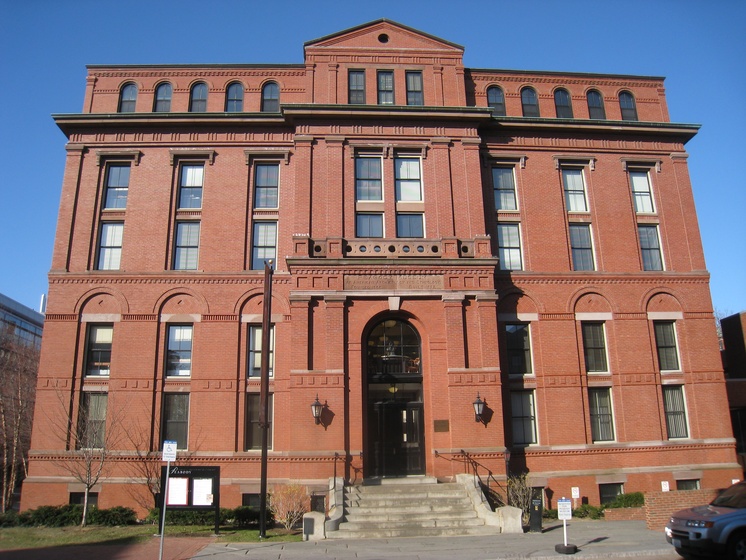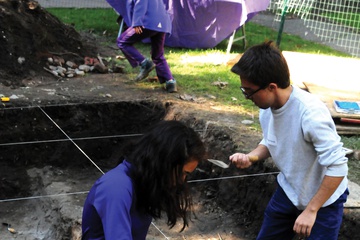I’m standing in the chilly back collections of the Peabody Museum of Archaeology and Ethnology, between rows of 72 life casts of Native American men of the Cheyenne, Arapahoe, Caddo, Kiowa and Comanche tribes. As Dr. Diana D. Loren tells me, these artifacts exemplify “special considerations” for curators.
The head-and-shoulders casts, taken from prisoners of war at Fort Marion, Florida in 1875, are arranged opposite one another at the behest of their descendants and contemporary tribal communities. A feather lies next to one, as per the Peabody’s policy of pairing descendants’ offerings to their ancestors with the relevant artifacts. They are kept in storage rather than permanent display, again at the request of their respective tribes.
Dr. Loren, who serves as director of academic partnerships and museum curator at the Peabody, explains that these busts were created for use in the 19th century discipline of phrenology, or measuring the human skull in order to develop theories about intelligence and behavior. Phrenology was based on antiquated archaeological preconceptions that certain races had different behavioral and intellectual qualities.
Loren discusses the difficulties of putting such “sensitive” objects on display in the museum. “Sensitive” is a frequently-used word in the world of ethnological and archaeological collections. As she explains, it applies to objects that are given special consideration because of consultations between a museum and the “community or descendant populations regarding a history and treatment of that collection.”
{shortcode-3a045e083651ec06a4afa1818b3f4e7935445ede}
Although by no means legally prohibited from displaying the life casts, the curators of the Peabody are hesitant to put them on display because of their fraught history. This kind history, Loren elaborates, lies at the heart of modern ethnological curators’ work: “How do you steward a collection in the 21st century, that was created in the 19th century, with different goals in mind?”
These concerns also extend to the audience of a hypothetical exhibit featuring the busts. “What are people going to come away with when they look at this kind of collection?” Loren asks. “How do you make them stop and hear the story of the life experiences of these individuals?”
One of the only remaining insights into this story comes from the busts’ creator. They were made under the supervision of Richard Henry Pratt, best known as the founder of the controversial Carlisle Indian Industrial School in Carlisle, Penn., where Loren notes that “children were taken away from their homes and families.” Pratt’s personal legacy is equally controversial: He advocated throughout his career for Native American assimilation into U.S. society, and is commonly said to have stated: “Kill the Indian to save the man.”
In his autobiography “Battlefield and Classroom,” Pratt describes his work with the prisoners of Fort Marion. He had relocated them from the New Mexico-Texas border to Florida as an initial experiment in Native American cultural assimilation. At Fort Marion, he forced the prisoners to wear military uniforms, to speak English, to cut their long hair, and to perform military drills.
He writes in his autobiography, “There was some objection to these changes, but by kindly persuasion it was gradually accomplished.”
Pratt’s students may not have shared his optimism. On the way to the fort, his autobiography details an escape attempt by one of the prisoners, Gray Beard, who throws himself out of the train and is later shot as he tries to escape. Pratt recalls Gray Beard saying that “he wanted to die ever since being chained and taken from home.”
Through Pratt’s words, readers gain some insight into the circumstances surrounding the busts’ creation, and the associated issues of racism and cultural imperialism—clearly, a difficult story to tell. At the same time, it may be one worth sharing with museum-goers in order to understand the history of the Peabody, and of the field of ethnology, in all its complexity.
Still, some believe that the life casts should not be shown at all.
In general, the Peabody has made a significant effort to recognize and engage with its own history. The museum is an active collaborator with organizations set up after the Native American Graves Protection and Repatriation Act of 1990, or NAGPRA. This act gives legal grounds to recognized Native American groups to repatriate funerary or cultural objects from museums and other organizations to the descendants. The Peabody has a full-time NAGPRA coordinator and has returned “2,361 individual remains, 154 funerary objects, one sacred object, 55 objects of cultural patrimony, and 18 objects that are both sacred objects and objects of cultural patrimony” to groups or individuals recognized under NAGPRA as of 2004, according to Loren.
Yet NAGPRA does not extend to the life-casts, which are not considered funerary or cultural objects. Will they ever find a home outside the Peabody’s back collections, either with their models’ descendants or on public display?
Moving forward, Loren says, the Peabody will continue to grapple with these issues, and “to work with [Native American] community members towards the co-development of knowledge. Recognizing there’s more than one story to tell.”




